There are various things to consider before you begin adjusting any image for AI processing. The first step is to obtain the photo just. To prevent interference, you could have to remove watermark from picture. Many watermarks obfuscate the picture and perplex the AI engine. Sometimes they fade into the background and create pointless noise. Little changes like image cleaning can have a significant impact.

Getting your photo ready calls some physical work. To get it just right, one combines common sense with a few photo-editing techniques. Start first with considering the resolution of your photograph. Usually, high resolution is a great advantage since greater detail helps the artificial intelligence perform. More pixels to work on allows you to more precisely remove the interference pattern. Images with at least 300 DPI demonstrate greater performance in several applications, according to tests. You can have a few years old picture or a freshly taken snapshot that requires some tidying. Either way, the focus you now give it pays off down road.
One can eliminate the watermark reminders in several methods. Often, outcomes that fit well combine cloning, smoothing, and blending methods. If the watermark is minor, sometimes just basic erasing suffices. In other situations, you will have to replicate a backdrop fit for the environment. I have tried my hand removing a tough watermark from a vibrant street scene photo. In art software, I ultimately manually mixed colors using a brush tool. Though it took some trial and error, the end picture seemed natural and tidy. The technique revived that authentic street vision free from synthetic disruptions.
If you choose to use a photo-editing application, you would be wise to use one with clever algorithms. One can find numerous reasonably priced choices available. Features and simplicity of use define programs somewhat differently. While some provide a “one-click” fix that automatically solves details, you may have to hand-adjust the results somewhat. When striving to preserve the intricacies, there is no replacement for meticulous corrections. Think about spending more time in the region including the watermark. Little time spent here now prevents later on quality loss. The secret is to mix the deleted area with neighboring pixels. For slow changes, use a low opacity soft-edged brush. Consider it as like polishing a rough area on a wooden table.
Before you start any modification, keep in mind to backup your original picture. Though many digital aficionados have discovered this lesson the hard way, it would seem logical. One mishap can produce permanent effects without a backup. Maintaining an unaltered duplicate provides a backup should the trial version of your work turn things messy. Even the best among us have digital errors; so, having that safety net is rather important.
Aligning and trimming your image for artificial intelligence processing is crucial. Cropping helps eliminate extraneous elements that could complicate picture identification systems. Here there is a balance: you want to eliminate pointless clutter but also maintain enough background for the artificial intelligence to grasp the image. It reminds me somewhat of bonsai tree grooming. Too much of either upsets natural ratios or causes anarchy. Changing brightness and contrast will also improve general appearance. Sometimes only changing these parameters may bring back information lost during watermark removal.

If you have time, drop in a few more specifics. Use sharpening filters later, for example, to gently bring some life back into the picture. Be cautious, though; over-sharpening may produce unwelcome artifacts. These little adjustments strike a careful equilibrium. Should you push them too far, you may find yourself with a picture that seems overly synthetic or computerized. Consider it as the spice in a great stew a bit here and there that makes all the difference. Your goal should be to eliminate the flaws while also maintaining the original charm of the image.
The general quality is largely influenced by the choice of file format. Various file formats meet different purposes. Although a JPEG file compresses the image and occasionally creates artifacts, it would seem like a suitable solution for daily shots. Conversely, with lossless storage a PNG file can preserve more of the original detail. Try these styles if you intend to further process your photos. Certain picture editing applications let you side-by-side compare versions. In this sense, you can see whether over time any changes influence the general quality. A side-by- side comparison can highlight even the most minute flaws requiring your attention.
AI processing sometimes be quite sensitive to minute alterations. Your earlier backup becomes absolutely crucial. Should the artificial intelligence misinterpret minute information, the resulting processed image could seem odd. One can relate this circumstance to following a recipe; every minute measurement counts. Apply straightforward, unambiguous changes. Complex modifications may produce surprising results. Imagine a chef who adds one more spice to transform the whole taste. Steer clear of it in your picture processing system.

Examining every part of the picture now will help you avoid problems down road. Search for minute areas where the background isn’t consistent. Look for color discrepancies where the watermark originally stood. One must rely mostly on manual confirmation. That is the best approach to find mistakes that automated instruments would overlook. Go back and change any errors you find in processing. Rely not just on program defaults. Your human eye often picks up minute elements that could be quite important.
Using automated watermark removal solutions should help you to control your expectations. Many say they handle the work flawlessly. Still, occasionally a personal touch is exactly what is required. Should something seem strange, rely on your gut feeling. The human eye detects subtleties that would elude planned behavior. Early on in my personal trip, I used a completely automated program and produced a hazy area in a beautiful setting. For me, it was a teaching moment a reminder that a better completed product results from a combination of human care and technology. Think of this as a friendly prod: occasionally mechanical settings are subordinated to hand corrections.
